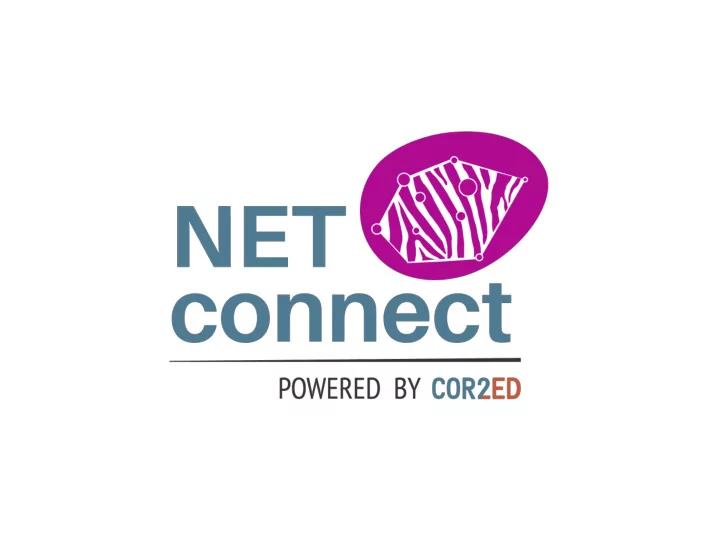

MEETING SUMMARY UPDATE FROM ENETS 2019 Barcelona, Spain Dr. Elettra Merola, MD PhD Gastroenterologist, Santa Chiara Hospital (APSS), Trento, Italy CLINICAL IMPACT OF THE WHO CLASSIFICATION 2017
DISCLAIMER Please note: The views expressed within this presentation are the personal opinion of the author. They do not necessarily represent the views of the author’s academic institution or the rest of the NET CONNECT group. This content is supported by an Independent Educational Grant from Ipsen. 3
NEW WHO CLASSIFICATION PERREN, A. ORAL PRESENTATION, ENETS 2019 & CONSEQUENCES FOR TREATMENT SORBYE, H. ORAL PRESENTATION, ENETS 2019 Lloyd, RV et al. WHO Classification of Tumours of Endocrine Organs, IARC Press, Lyon, 2017 • 4
BACKGROUND GEP NEN are classified into three groups based on mitotic activity and • Ki-67 index in the WHO 2010 classification. 1 It included three distinct groups: – well-differentiated NET (G1 or G2) – poorly-differentiated NEC G3 – mixed adenoneuroendocrine carcinomas (MANEC) New observations and publications provided new understanding into • PanNEN, which prompted the new WHO update in 2017 2 – key changes and clinical implications are presented – publication of the fifth edition of the WHO Classification of Tumours of the Digestive System is expected in April 2019 GEP, gastroenteropancreatic; NEC, neuroendocrine carcinomas; NEN, neuroendocrine neoplasm; NET, neuroendocrine tumours; PanNEN, pancreatic neuroendocrine neoplasm; WHO, world health organisation. 1. Klimstra, DS et al. WHO Classification of Tumours of the Digestive System, IARC Press, Lyon, 2010. 5 2. Lloyd, RV et al. WHO Classification of Tumours of Endocrine Organs, IARC Press, Lyon, 2017.
COMPARISON OF RECENT WHO CLASSIFICATIONS WHO classification 2010 WHO classification 2017 For pancreatic NENs Ki-67 Mitotic Ki-67 Mitotic index index index index Well differentiated NETs Well differentiated NETs NET G1 ≤2% < 2/10 HPF NET G1 <3% <2/10 HPF NET G2 3%-20% 2-20/10 HPF NET G2 3%-20% 2-20/10 HPF NET G3 >20% >20/10 HPF Poorly differentiated NECs Poorly differentiated NECs NEC G3 >20% >20/10 HPF NEC G3 >20% >20/10 HPF - Small cell type - Large cell type Mixed adenoneuroendocrine carcinoma Mixed neuroendocrine-nonneuroendocrine neoplasm (MANEC) (MiNEN) HPF, high power fields; NEC, neuroendocrine carcinomas; NEN, neuroendocrine neoplasm; NET, neuroendocrine tumours; PanNEN, pancreatic neuroendocrine neoplasm; WHO, world health organisation 1. Klimstra, DS et al. WHO Classification of Tumours of the Digestive System, IARC Press, Lyon, 2010. 2. Lloyd, RV et al. WHO Classification of Tumours of Endocrine Organs, IARC Press, Lyon, 2017. 6 Perren, A. Summary of oral presentation at ENETS 2019.
KEY CHANGES IN WHO CLASSIFICATION 2017 Grade 1 to 2 Ki-67 cut- off moved from ≤ 2% to < 3% • Two groups of patients within G3 category are defined:- • – NET G3 – well differentiated morphology – NEC G3 – poorly differentiated morphology Naming of mixed cell tumours changed from MANEC to MiNEN • MANEC, mixed adenoneuroendocrine carcinoma; MiNEN, mixed neuroendocrine non-neuroendocrine neoplasms; NEC, neuroendocrine carcinomas; NET, neuroendocrine tumours; WHO, world health organisation Lloyd, RV et al. WHO Classification of Tumours of Endocrine Organs, IARC Press, Lyon, 2017. 7 Perren, A. Summary of oral presentation at ENETS 2019
THERAPEUTIC OPTIONS NET G3 NEC G3 Somatostatin-based therapy Platinum-based chemotherapy • • (when receptors expressed) Second-line therapy to be defined • Targeted therapies • Role of surgery and • Non-platinum-based immunotherapy to be defined • chemotherapy (i.e. TEMCAP) Role of surgery and • immunotherapy to be defined Morphology is not the only important feature! • NET G3 with very high Ki-67: • NEC G3 with not very high Ki-67: – may benefit from platinum- – other options such as NET G3 based chemotherapy (e.g. TEMCAP or targeted therapies) NEC, neuroendocrine carcinomas; NET, neuroendocrine tumours; TEMCAP, Temozolomide-Capecitabine chemotherapy. 8 Sorbye, H. Summary of oral presentation at ENETS 2019; Sorbye H et al. Endocrinol Metab Clin North Am 2018; 47:683-98.
SUMMARY Previously defined G3 group divided based on tumour morphology into • NET G3 and NEC G3 Anticipate that future updates will propose a similar classification also • for other tumour primary sites. Waiting for the new WHO classification for other digestive NENs to be released – expected April 2019 NEC, neuroendocrine carcinomas; NEN, neuroendocrine neoplasm; NET, neuroendocrine tumours; WHO, world health organisation 9
REACH NET CONNECT VIA TWITTER, LINKEDIN, VIMEO AND EMAIL OR VISIT THE GROUP’S WEBSITE http://www.net-connect.info Join the Watch us on the Email Follow us on Twitter NET CONNECT Vimeo Channel antoine.lacombe@ @net_connectinfo group on LinkedIn NET CONNECT cor2ed.com 10
NET CONNECT Bodenackerstrasse 17 4103 Bottmingen SWITZERLAND Dr. Antoine Lacombe Pharm D, MBA Phone: +41 79 529 42 79 antoine.lacombe@cor2ed.com Dr. Froukje Sosef MD Phone: +31 6 2324 3636 froukje.sosef@cor2ed.com
Recommend
More recommend